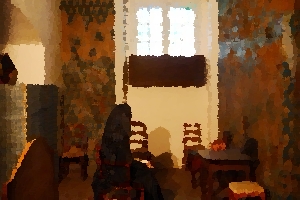The Conciergerie is a fortress in Paris, France that used to house kings and subsequently prisoners. It served as the Royal Apartments before completing the Louvre, which became the new Royal Residence. La Conciergerie was constructed during the early part of the 14th century. It came with a guardroom, a kitchen and a men-at-arms room. This was built by the architects Jean de Saint-Germer and Nicolas des Chaumes. It was originally an extension of the royal Palais de la Cite, and it stands beside the twin towers (the Tour de Cesar and the Tour d'Argent).
It gained its notoriety during the French Revolution when thousands were imprisoned here before they were brought to Concorde Square, where they were guillotined before an angry mob. There is a room that holds a record of all 2,780 men and women who were executed here. Among the illustrious personages that made it their 'home', Charlotte Corday (who is said to have stabbed Marat while he was bathing) and Danton.
 Reconstitution of the prison cell of Marie Antoinette, queen of France. [CC] credit.
Reconstitution of the prison cell of Marie Antoinette, queen of France. [CC] credit. Marie-Antoinette was perhaps the most famous name found in the 'guest list', Louis XVI's wife, who enraged the French people with her alleged remarks about bread and cake. There is a reconstruction of her dungeon, and you can see how she lived the last days of her life. The place where she actually stayed during her imprisonment has since been converted into a chapel upon Louis XVIII's behest. The Chapel is now known as the Chapel Expiatoire.
You can imagine the change from it being a place of grandeur where kings held their banquets and balls to a place that is dark and bleak, a place of torture and hopelessness. This was where prisoners, particularly those who are enemies of the monarchy and nobility, suffered unbelievable tortures. A prime example would be Ravaillac, Henri IV's assassin. Prior to his execution, he was 'bathed' with boiling oil, and his flesh was pricked with hot lead.
Other features include the Salle de la Derniere Toilette (or the Grooming Room). Ironically, this is where the beleaguered prisoners were made to surrender their possessions. This is also the place where the back of the prisoners' necks are shaved before their trip to the guillotine.
For those who find these too bleak, you can also visit the colonnaded Salle des Gens d'Armes, which is an elegant hall that is wide enough for concerts, and the Salle des Gardes, which features elaborate vaulting. There is also the Cuisines (Kitchen), which features four humongous fireplaces. Each of these is big enough for you to roast an entire ox, and we're not joking about that.
The complex also includes the four towers, namely, the Clock Tower (housing the first public clock in the country), the Caesar Tower, the Bon-Bec Tower (where confessions from criminals are extracted by torture), and the Silver Tower (where the Crown Jewels were said to be kept for a time).
La Conciergerie is not just a historical attraction; it is also worth a visit because it is a prime example of Gothic architecture. It faces the Seine River and houses three Gothic halls.